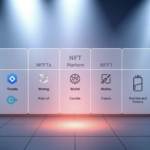Now Reading: Artificial Intelligence Blockchain Identity Verification Explained
- 01
Artificial Intelligence Blockchain Identity Verification Explained
Artificial Intelligence Blockchain Identity Verification Explained

This guide maps how smart systems and distributed ledgers join to secure digital identity verification across modern services. It defines core terms and shows why the United States needs updated digital identity management for remote onboarding and cross-border flows.
We cover enrollment, credentials, attestations, biometrics, and risk scoring in simple end-to-end flows. The text explains how tamper-evident records pair with pattern analysis to reduce fraud and lower friction for users and businesses.
Later sections preview architecture layers: data capture, AI analytics, decision orchestration, ledger-based attestations, and compliance logging. Expect practical steps for deployment, governance, and measuring ROI while keeping accuracy, fairness, and transparency at the center.
Key Takeaways
- Combining smart models with distributed ledgers strengthens digital identity verification and lowers fraud.
- Legacy systems strain under remote onboarding and cross-border transactions—modernization is urgent.
- End-to-end flows include enrollment, credentials, biometrics, risk scoring, and ongoing authentication.
- Immutable records and anomaly detection help scale secure, privacy-conscious systems for users.
- The guide follows a clear path from challenges to tech stacks, implementation, and ROI.
Executive Summary: Why Digital Identity Needs a Rethink Today
Centralized record keeping concentrates risk and no longer matches the threat landscape or user expectations. Large, single-purpose databases create single points of failure and make organizations prime targets for data breaches and identity theft.
We need a shift from brittle, manual processes toward user-centric digital identity that gives individuals control over consented information sharing. Decentralized approaches distribute trust across systems and reduce exposure from any one compromise.
The role of modern models is to improve match rates, liveness checks, and anomaly detection during onboarding and re-authentication. These methods lower false rejects, speed approvals, and help organizations meet evolving regulatory demands.
Immutable audit trails anchored on distributed ledgers strengthen assurance by preserving attestations and verification outcomes for later review. That auditability supports compliance and builds trust between users and organizations.
- Priorities: consistent cross‑channel processes, interoperability of digital identities, and scalable decisioning under peak demand.
- Benefits: lower friction for users, stronger security for organizations, and fewer successful identity theft attempts.
- KPIs to track: fraud reduction, time‑to‑verify, and user satisfaction—these justify management investment.
This guide then reviews the technology stack, compliance realities, and a practical implementation roadmap so organizations can adopt secure, privacy‑by‑design systems that meet real operational needs.
Foundations: How AI and Blockchain Fit Together in Digital Identity
When algorithms analyze documents and networks while ledgers record attestations, organizations gain both speed and trust.
Machine-learning tools for credential checks
Computer vision reads documents and compares faces to photos. NLP extracts names and dates from text fields. Graph analytics links accounts, devices, and events to surface risk signals quickly.
Distributed ledgers and smart contracts for trust
Replicated ledgers store tamper‑evident event logs for attestations and revocation lists. Smart contracts can codify issuer trust rules and time‑bound permissions, cutting manual steps.
Integration points tie these layers together. AI outputs like risk scores and liveness results trigger on‑chain records (hashes or summaries) for audit. Sensitive data stays off‑chain while proofs preserve integrity and privacy.
- Provenance: ledger trails help validate training data sources for models.
- Resilience: node replication reduces tampering and downtime risk.
- Operational note: keep latency‑sensitive checks off‑chain; anchor summaries on‑chain.
| Capability | Role | Benefit | Example |
|---|---|---|---|
| Computer vision | Document and face matching | Faster, accurate checks | Passport photo match |
| Smart contracts | Policy automation | Lower manual work | Issuer revocation rules |
| Distributed ledger | Immutable logs | Auditability and provenance | Anchored event hashes |
What’s Broken in Legacy Identity Systems
Many legacy identity platforms put too much trust in a single data store, and that design choice creates outsized risk.
Single point of failure and the cost of centralized data breaches
Centralized architectures concentrate sensitive data in one place. When attackers succeed, breaches cascade and expose millions of personal records.
Remediation costs, regulatory fines, and reputational damage follow. Those expenses hit operations and customer trust alike.
Limited user control and interoperability gaps
Individuals rarely see or revoke how their information is shared. That lack of consent control harms users and makes compliance harder.
Interoperability gaps force repeated checks across institutions. Duplicate processes slow onboarding and raise operational risk.
- Centralized stores create a single point of failure that magnifies fraud and identity theft.
- Outdated technology and manual processes increase error rates and processing time.
- Weak data provenance and siloed systems prevent reusable claims across relying parties.
Fixing these problems requires rethinking architecture, governance, and protections for individuals. Replacing siloed data with verifiable claims, stronger encryption, and consent controls reduces risk and speeds secure verification across systems.
The Shift to Decentralized Identity and Self‑Sovereign Models
Portable identifiers and signed claims let people share only what a service needs. Decentralized frameworks give individuals cryptographic control of credentials and consented sharing. This reduces middlemen and streamlines cross‑service flows.

Decentralized identifiers and verifiable credentials
Decentralized identifiers (DIDs) are cryptographic references that travel with a user. DIDs enable portable, interoperable digital identity across ecosystems.
Verifiable credentials are digitally signed attestations from trusted issuers. Individuals present them to relying parties for quick, secure identity verification without reissuing records.
Zero‑knowledge proofs, selective disclosure, and revocation controls
Zero‑knowledge proofs let someone prove a fact—like being over a certain age—without revealing raw personal information. This supports strong privacy and reduces data exposure.
Selective disclosure adds granularity: users send only the fields needed for a transaction. Revocation lists or status registries let relying parties check if a credential is still valid in real time.
| Component | What it does | Benefit |
|---|---|---|
| DID registry | Stores public keys and service endpoints | Enables portable, verifiable references |
| Verifiable credential | Signed claim from an issuer | Reusable proof for multiple services |
| Zero‑knowledge proof | Proves attributes without data leaks | Improves privacy and lowers risk |
| Revocation list | Publishes credential status | Supports real‑time checks and security |
How this helps organizations: these patterns increase trust, cut repeated checks, and align with U.S. privacy expectations. Keeping sensitive payloads off‑chain while using on‑chain registries preserves auditability and enhances security.
artificial intelligence blockchain identity verification
Combining biometric, behavioral, and document forensics with anchored attestations raises assurance across user flows. Models score liveness, facial recognition results, and document authenticity in real time. Those outputs then produce cryptographic proofs that are anchored for audit.
Decentralized attestations reduce tampering by storing status and hashes across nodes instead of a single repository. Sensitive payloads remain off-chain while compact anchors prove integrity without revealing raw information.
Real-time decisioning routes risky cases to manual review and lets systems adapt thresholds for high-value flows like account opening or large transfers. This lowers fraud and cuts false declines for legitimate users.
- Speed & accuracy: model scores plus on‑chain proofs shorten time-to-approve.
- Auditability: anchored records support disputes and compliance reviews.
- Resilience: distributed evidence reduces single-point compromise.
| Stage | What models do | On-chain role |
|---|---|---|
| Enrollment | Facial recognition, document forensics | Anchor hashes of attestations and revocation rules |
| Ongoing auth | Behavioral signals and liveness checks | Store event summaries for audit trails |
| High-risk review | Risk scoring and anomaly detection | Provide immutable evidence for investigations |
As verified events accumulate, feedback loops improve model quality using proofs with known provenance. Organizations gain consistent, transparent processes that reduce fraud and identity theft while improving throughput for users.
Learn how self-sovereign models and on-chain registries support these flows at self-sovereign identity.
The Core Technology Stack for Digital Identity Management
A practical tech stack ties capture, scoring, orchestration, and tamper-evident recording into a single flow. This section maps components and how they work together to protect users and reduce fraud.
Facial recognition and behavioral biometrics
Facial recognition and behavioral patterns speed checks and improve liveness detection. Vision models match photos while behavioral signals track typing, motion, and session context.
These inputs feed risk scoring so systems can reduce false declines and flag spoofing attempts early.
Two‑factor / multi‑factor vs. knowledge‑based checks
2FA and MFA combine something you have (device token) and something you are (biometrics) to raise assurance. They outperform knowledge‑based authentication, which often relies on facts attackers can discover.
Use layered factors for high‑value flows and opt for frictionless checks on low‑risk paths.
Encryption, tokenization, and passwordless flows
Encrypt data in transit and at rest, and tokenize sensitive information to limit exposure across systems. Device‑bound credentials enable passwordless logins without need for static secrets.
Passwordless approaches cut phishing risk and improve user experience while keeping security strong.
Smart contracts and hybrid on‑chain/off‑chain patterns
Smart contracts codify policy, issuer hierarchies, and revocation checks for consistent enforcement. Store protected payloads off‑chain and anchor hashes on a distributed ledger to balance transparency and privacy.
- Core stack layers: capture, verification services, decisioning, orchestration, and durable recording.
- Risk data enrichment and device signals feed AI scoring to reduce friction for legitimate users.
- Operational needs: API performance, model drift monitoring, and key management for resilient systems.
| Component | Role | Benefit |
|---|---|---|
| Capture | Collect documents, photos, device signals | Accurate inputs for scoring |
| Decisioning | Risk scoring and policy engine | Consistent, adaptive outcomes |
| Recording | On‑chain anchors + off‑chain storage | Auditability with privacy |

Security, Privacy, and Reducing Risk
Protecting personal information requires layered controls, auditable consent, and models that spot anomalies as they happen. These measures help balance user convenience with strong security.
AI‑driven anomaly detection and fraud risk scoring
Real‑time models monitor transactions, device signals, and behavior to flag unusual patterns. Scores are actionable and map directly to workflows that step up checks for higher risk.
Teams tune thresholds to business context so systems escalate only when needed. Continuous feedback improves model accuracy and reduces false declines.
Privacy‑preserving techniques: data minimization and consented sharing
Data minimization keeps only what is necessary and stores proofs separately from raw personal data.
Consented sharing gives individuals granular control over what they disclose and when. Transparent consent logs provide auditable trails for regulators and users.
- Decentralized attestations remove a single point failure by scattering proofs across nodes.
- Layered controls—encryption, tokenization, access policies—provide defense in depth.
- Transparent revocation and real‑time status checks cut risk from compromised credentials.
| Control | Purpose | Benefit |
|---|---|---|
| Anomaly detection | Monitor behavior and transactions | Early fraud signals, adaptive risk scoring |
| Consented sharing | Grant/revoke access to personal data | User control, auditable consent trails |
| Decentralized attestations | Store tamper‑evident proofs off central stores | Reduce exposure from data breaches |
| Layered security | Encryption, tokenization, access policies | Defense in depth and reduced attack surface |
Compliance Realities in the United States and Beyond
Regulatory frameworks now demand traceable proofs and clear audit trails across digital onboarding and ongoing checks.
EU rules and KYC/AML expectations
5AMLD raised standards for e‑money and crypto services. It requires strong customer due diligence, reliable documentary and data sources, and ongoing transaction monitoring.
Organizations must keep records that show provenance and check status over time. This supports anti‑money laundering controls and reduces abuse.
U.S. policy direction and public‑private efforts
The Improving Digital Identity Act pushes for interoperable, privacy‑preserving systems through federal coordination. Collaboration between agencies and industry is a key outcome.
Public‑private models can speed adoption while protecting personal data and user control.
Designing for audits, traceability, and monitoring
Good designs include immutable verification logs, transparent revocation status, and clear issuer provenance. These features simplify audits and regulatory inquiries.
- Align workflows to KYC/AML while minimizing sensitive data exposure.
- Govern issuer trust lists, credential schemas, and smart contract updates.
- Implement continuous monitoring and reporting to detect suspicious activity.
Decentralized attestations and standard interfaces make cross‑border compliance more feasible. Architectures should stay adaptable as rules evolve, and teams should engage regulators early to clarify expectations.
From Vision to Production: Implementation Roadmap and Integration
Moving from concept to live systems requires a clear, phased roadmap that ties technology choices to measurable outcomes. Start with discovery and threat modeling, then pick vendors who match your compliance and performance needs. Run a short pilot before scaling and harden controls during rollout.
Data pipelines, model training integrity, and bias mitigation
Design data flows with provenance tracking and labeling quality checks. Keep training datasets verifiable and reproducible so audits can connect decisions to evidence.
Guardrails should include continuous validation, drift detection, and challenger models to limit bias and lower risk.
Choosing a ledger: public, permissioned, or hybrid approaches
Compare public vs. permissioned vs. hybrid on trust, cost, privacy, and throughput. Permissioned networks fit regulated use cases; public ledgers offer wide auditability; hybrids balance both.
| Ledger Type | Trust Model | Cost & Throughput | Privacy |
|---|---|---|---|
| Public | Open consensus | Lower trust cost, variable throughput | Lower privacy unless off‑chain |
| Permissioned | Consortium control | Higher cost, higher throughput | Better privacy controls |
| Hybrid | Selective anchors | Balanced cost/perf | Good privacy via off‑chain storage |
User experience, recovery flows, and accessibility without need for technical expertise
Make onboarding clear with minimal steps and plain disclosures. Provide non‑technical recovery: email delegation, hardware‑backed key recovery, and social or custodial fallback options.
Integrate APIs so orchestration engines connect to verification providers and on‑chain anchors. Include rate limiting, step‑up checks, and continuous risk evaluation to reduce fraud while preserving usability.
- Rollout plan: discovery, pilot, scale, training, and measurable KPIs (time‑to‑verify, fraud reduction, user satisfaction).
- Key management: hardware keys, secure backups, and tested recovery flows.
- Compliance: auditable logs, access controls, and evidence retention aligned to regulators.
Scalability and Performance Considerations
Performance design determines whether real‑time checks feel instant or cause costly drop‑offs. Plan for sub‑second liveness checks and credential status reads to keep user flows smooth.
Throughput needs: use batching, sidechains, or rollups to anchor many attestations without clogging the main ledger. Keep heavy payloads off‑chain and store only compact hashes to cut latency and fees.
Balance on‑chain finality and off‑chain speed. Tune trade‑offs so critical UX paths stay responsive while retaining tamper‑evident proofs for audits.
- Partition and cache recent status data to serve peaks rapidly while protecting sensitive information.
- Deploy multi‑region clusters and automated failover for continuous service during outages.
- Monitor ML pipelines and nodes for bottlenecks; set SLOs and alerts to preserve performance.
| Area | Strategy | Benefit |
|---|---|---|
| Latency | Off‑chain checks + cached status | Sub‑second user responses |
| Throughput | Batch anchors, rollups, sidechains | Lower on‑chain congestion and fees |
| Resiliency | Multi‑region failover, retries | High availability under load |
| Crypto ops | Hardware acceleration, optimized libs | Faster signing and verification |

Test with load testing and chaos experiments before scale‑up. That validates assumptions and keeps cost‑performance sustainable as volumes grow.
Real‑World Use Cases Powering Digital Identities
Practical deployments show how modern credential flows speed service activation across sectors. Below are concrete examples that highlight user benefits, process improvements, and measurable risk reduction.
Financial services: faster onboarding and reusable KYC
Banks use document capture and facial recognition to speed checks at account opening. AI models flag high-risk cases and trigger step-up flows only when needed.
Reusable credentials let customers present a single, auditable proof to multiple institutions. That reduces repeated KYC, lowers onboarding time, and shrinks opportunities for identity theft.
Healthcare: secure records and consent management
Patients control sharing of personal information and sensitive information among providers. Consent logs and off‑chain storage keep medical payloads private while on‑chain anchors record access events for audits.
This approach supports secure data exchange for care coordination and diagnostics without broad data exposure.
Government services: benefits, voting, and citizen IDs
Verifiable credentials streamline eligibility checks for benefits and enable tamper‑resistant citizen IDs. Vote records can be anchored to preserve integrity of event histories while preserving voter privacy.
Supply chains and retail: provenance and authenticity
Product identities and provenance proofs reduce counterfeits and simplify compliance reporting. Retailers and consumers can confirm origin and movement using shared registries that blockchain ensures are tamper‑resistant.
Cross‑industry gains:
- Faster service activation and fewer false positives.
- Step‑up verification based on risk scoring focuses friction where needed.
- Opportunities to remove passwords in recurring interactions so users act without need to remember secrets.
| Sector | Primary use | Key benefit |
|---|---|---|
| Financial services | Reusable KYC, onboarding | Faster approvals, reduced fraud |
| Healthcare | Consented records sharing | Privacy with auditability |
| Government | Benefits eligibility, citizen IDs | Efficient checks, tamper‑resistant logs |
| Supply chain | Provenance and product proofs | Reduced counterfeits, compliance |
Business Value, Challenges, and ROI
Reusable digital identities can cut KYC costs and speed onboarding for banks and other businesses. Large firms often spend millions yearly on manual checks. Sharing verified claims lowers repeated work, shortens wait times, and improves conversion.

Cost and efficiency optimization with reusable digital identities
Reusable credentials let organizations accept existing attestations as evidence. That reduces duplicated document reviews and manual reconciliation.
Result: lower operational overhead and faster approvals, which translate to saved staff hours and fewer drop-offs.
Change management, vendor selection, and integration risks
Adoption requires training, process redesign, and stakeholder alignment.
Watch for vendor lock-in, interoperability gaps, and unclear data lineage. Mitigate these with open standards, audited connectors, and clear contracts.
KPIs: fraud reduction, time‑to‑verify, and customer satisfaction
Track fraud rates, time‑to‑verify, approval rates, step‑up incidents, and satisfaction scores. Use telemetry and risk data to focus investments where friction cuts fraud most.
| Metric | What to measure | Business impact | Sample target |
|---|---|---|---|
| Cost avoidance | Saved KYC spend per year | Lower operating expenses | 30% reduction in manual review |
| Fraud & loss reduction | Incidents and charge-offs | Reduced losses from identity theft | 20% fewer fraud cases |
| Conversion uplift | Approval rate & drop-off | More revenue captured | 5–8% higher conversions |
| Compliance & auditability | Timely reports and logs | Lower regulatory risk | 100% auditable trails |
Simple ROI model: add annual KYC cost avoidance, expected fraud loss reduction, and incremental revenue from higher conversions. Subtract implementation and ongoing management costs to estimate payback.
Shaping the Future: Emerging Technologies and Next Steps
New technologies—secure wallets, verifiable compute, and privacy-enhancing cryptography—are converging to make digital checks faster and safer.
Advanced biometrics, verifiable computation, and selective disclosure reduce raw data sharing while improving security and auditability. These tools help businesses and organizations lower fraud and preserve user privacy.
Decentralized wallets and standard formats let digital identities travel across services with consent and portability. Interoperable stacks and cross-network integration patterns avoid fragmented evidence and duplicate data storage.
Regulatory signals in the U.S. favor privacy-preserving, interoperable approaches. Start with a pilot, track KPIs (time-to-verify, fraud reduction, user satisfaction), harden governance, and expand integration as results prove out.
Collaborate with vendors, regulators, and communities, invest in standards like DIDs and verifiable credentials, and launch a pragmatic roadmap that balances innovation with compliance.















